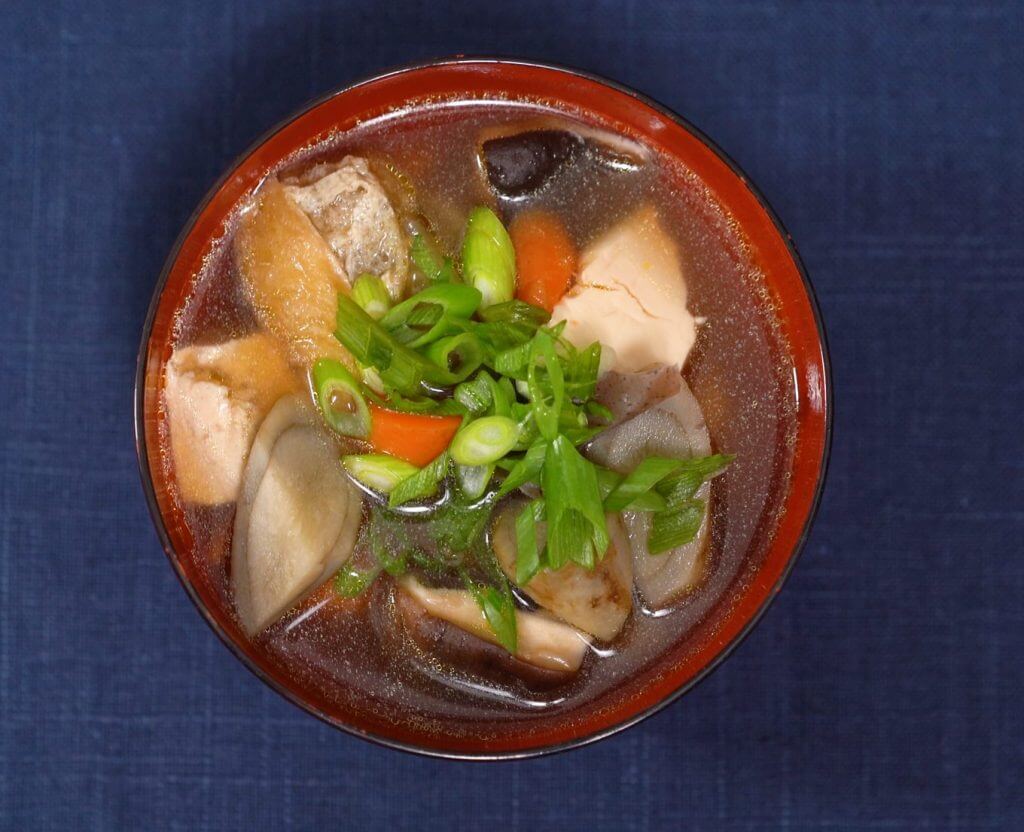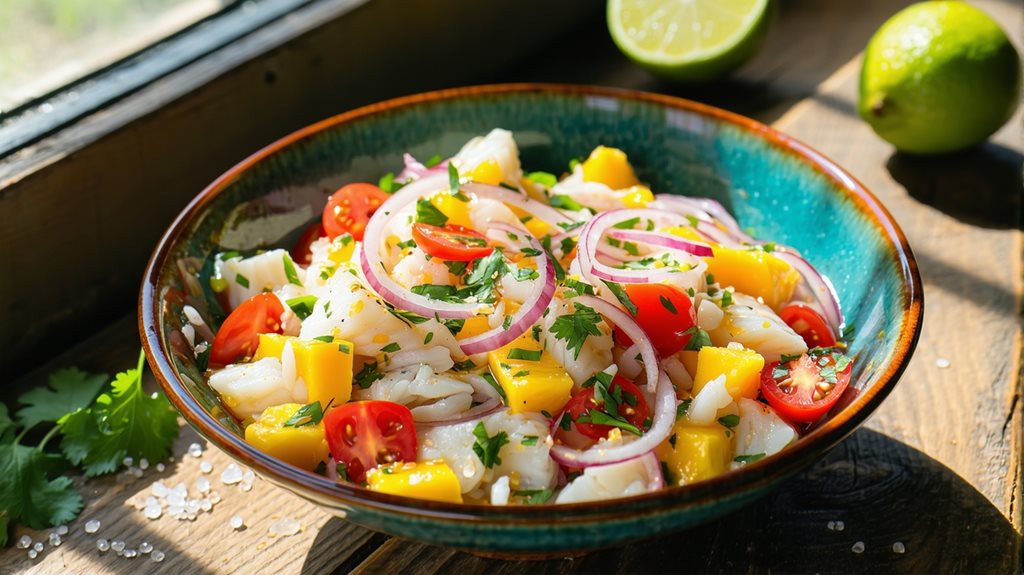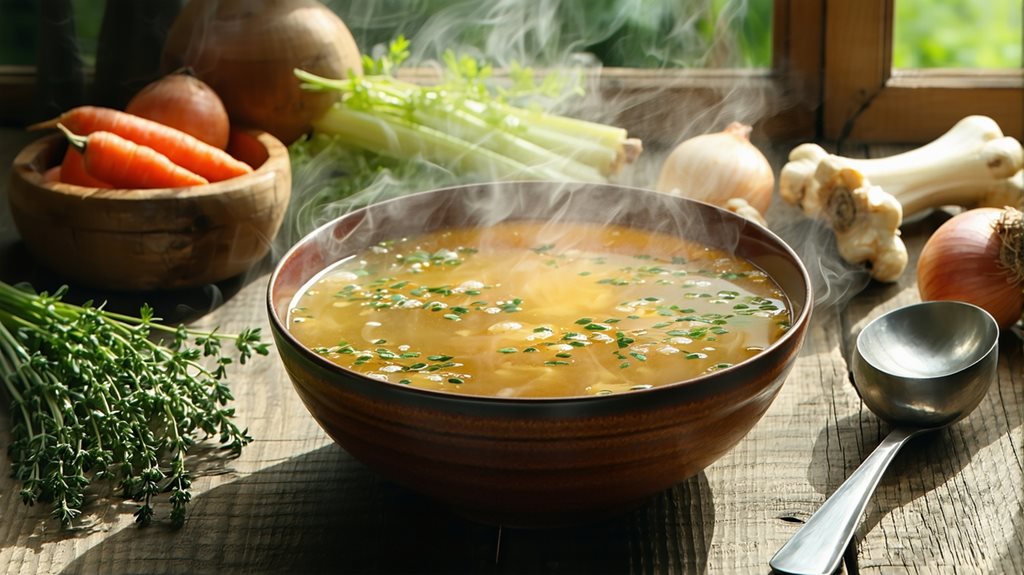Love root vegetables? As someone who also enjoys them, this could soon be one of your favorite ways to cook them. Thanks to gobo (burdock root) this soups full of flavor, completely filling and perfect as a side or even as your main dish. Make sure to read through the end to get all my tips to make it.

what is kenchinjiru?
Kenchinjiru is a traditional Japanese soup made with vegetables, tofu, and sometimes meat or fish. It is typically flavored with dashi.
Dashi can be made from a variety of different ingredients, but this one is made with just konbu and dried shiitake mushrooms.
Kenchinjiru is likely one of the healthiest and most nutritious dishes you could eat; whether you’re visiting and enjoying as part of a vegetarian or Buddhist meal (this type of cooking is known as shojin ryori.)
Or if you want to cook it, check out the recipe and my best tips below.

Japanese Buddhist cuisine (shojin ryori)
As you may know, shojin ryori is a traditional style of cooking that is based on the dietary restrictions of Buddhist monks.
If you’re new here, basically shojin ryouri is a vegetarian style of cooking that does not use any meat, fish, or other animal products.
Instead, it focuses on using a variety of vegetables, grains, and legumes, as well as soy products such as tofu and soy sauce and other traditional japanese ingredients.
Some of the common ingredients used in shojin ryori include:
- Tofu: A versatile ingredient that can be used in a variety of dishes, such as soups, stews, and stir-fries.
- Daikon radish: A large, white radish that has a mild, slightly sweet flavor. It is often used in soups and stews, or simmered just like this nimono (Japanese simmered food)
- Carrots: Used to add sweetness and color to dishes.
- Shiitake mushrooms: Add a rich, savory flavor to soups and stews.
- Gobo: also known as burdock root, this long, brown root vegetable has a wonderful earthy, nutty and slightly bitter taste.
- Sesame seeds and sesame oil: Used to add flavor and texture to dishes.
- Wakame seaweed: A type of seaweed that is often used in soups and salads.
Shojin ryori dishes are often prepared with minimal seasoning, and instead rely on the natural flavors of the ingredients.
Many dishes are also served in small portions and arranged beautifully on the plate (as you can see above.)
Shojin ryori is often associated with Zen Buddhism and is often served at temples, shrines and monasteries in Japan. (like the photo below from my last visit to Mt. Koya, Japan)
Even though that’s one place you can find them, there are places outside of those places too.

where can you eat kenchinjiru?
Kenchinjiru can be found at many traditional Japanese restaurants, particularly those that specialize in vegetarian or Buddhist cuisine.
It can also be found at some izakaya (Japanese pubs) and casual eateries.
Some Japanese supermarkets also carry pre-made kenchinjiru in their frozen food sections.
Some Japanese families also make kenchinjiru at home.
Especially in the bitter cold months of winter.
Looks cold down there, doesnt it?
why you might want to cook kenchinjiru
For one thing, there’s nothing like hot soup on a cold winter day.
Second, kenchinjiru is a flavorful and nourishing soup that’s a great way to incorporate a variety of vegetables into your diet.
It’s also a great option if you’re looking to reduce your meat consumption.
Last although I’d have to say daikon radish is my favorite part, it’s a very versatile dish.
You can add or remove ingredients to your liking and it’s a great way to use leftover vegetables.
like, what are you going to do with that half piece of daikon radish that you grated…
now you have a simple way to use it!
Kenchinjiru: the ultimate japanese vegetable soup
Love root vegetables? As someone who also enjoys them, this could soon be one of your favorite ways to cook them. Thanks to gobo (burdock root) this soups full of flavor, completely filling and perfect as a side or even as your main dish. Make sure to read through the end to get all my tips to make it.
- Prep Time: 20
- Cook Time: 30
- Total Time: 50 minutes
- Yield: 6 servings 1x
- Cuisine: japanese
Ingredients
- 4–5 in. piece of daikon radish, sliced into half moon pieces, 1/4 in. thick
- 1 1/2 cups gobo, (burdock root) rangiri*
- 1 tsp fresh ginger, sliced
- 1 cup carrots, rangiri**
- 1 Tbsp olive or sesame oil
- 1 cup fresh shiitake mushrooms, sliced
- 2 pieces aburaage, (fried tofu skins, 2 x 6 in. each) sliced
- 1/2 block konnyaku (3.5 oz), parboiled and torn with a spoon into small pieces
- 1/2 block tofu (7 oz.), drained and cut into bite size pieces
- 4 cups dashi
- 1 Tbsp mirin
- 2 Tbsps sake
- 1 1/2 Tbsps soy sauce
Instructions
- Using a large pot, add the oil and cook carrots, daikon, and gobo for 2-3 minutes.
- Add in the ginger, shiitake, aburaage, konnyaku, tofu, dashi, mirin, and sake. Cover partially with a lid and simmer for about 10 minutes.
- Add the soy sauce and simmer for another 5 minutes partially covered.
- Serve with desired toppings as a side or with a bowl of rice for a complete meal!
Notes
- *For gobo, scrape off outside skin using back edge of knife to remove excess dirt. If not using immediately, soak cut pieces in a bowl of water to remove bitter flavors and prevent oxidation.
- **Rangiri (乱切りrandom cut), is a cutting technique where you rotate a round vegetable ¼ inch at a time and then cut it at an angle. This helps to increase the surface area for better flavor and even cooking. Visit alldayieat.com/go/bookresources for a mini video tutorial on this cutting technique.
- Parboiling the konnyaku for 2-3 minutes helps to remove some of the unpleasant flavor and smell along with some of the water inside. Tearing the konnyaku either by hand or with a spoon helps to increase the surface area to allow for the broth flavor to be absorbed better.
- For the aburaage, you can reduce some of the oil you eat by parboiling it for 1-2 minutes in water and then draining before using. The trade off is you’ll lose a little bit of flavor from the oil. If you do this, make sure to squeeze out all the water it absorbed before adding it to the soup.
- When cooking the konsai (根菜 root vegetables such as daikon radish, carrot and gobo), consider allowing them to brown slightly for extra flavor and umami.




Konnichiwa! (Hello!) I'm Pat Tokuyama, a Japanese tofu cookbook author, who travels for music, food, and adventure. If you like Japanese tea, checkout some of the newestorganic japanese tea, matcha bowls and noren and more!
** Curious about the Plant Based Japanese Cooking Club? ** Learn more here!
Here are a few tips for making a delicious kenchinjiru:
Use high-quality dashi: Dashi is the base of the soup, so it’s important to use a good quality dashi to get the best flavor. You can make your own vegetarian dashi using my recipe here, or if you prefer the flavor of fish, you can try this one. And of course the ever so convenient instant dashi powder or granules too.
Don’t overcook the vegetables: Kenchinjiru is best when the vegetables are cooked just until they are tender but still retain their color and shape. Overcooking them will make them mushy and possibly disintegrate. (Daikon radish especially)
Adjust the seasoning to your taste: You can adjust the soy sauce and sesame oil to suit your taste. Add some ichimi or shichimi red pepper flakes.
Add protein of your choice: Kenchinjiru is traditionally made with tofu, but you can also add meat, fish or seafood for a non-vegetarian version.
Be creative with your vegetables: Feel free to mix and match vegetables to your liking, you can use carrots, daikon, burdock, pumpkin, sweet potatoes, yams, leek, mushrooms, ginger, etc. Though root vegetables in the recipe are the traditional ingredients, sometimes it’s nice to change things up. Isn’t it?
Serve with garnish: Kenchinjiru is usually served with some garnish, like chopped green onions, grated ginger, or a sprinkle of sesame seeds.
Next time you make kenchinjiru, would you top it with ginger or green onion?
let me know in the comments !







Konnichiwa! (Hello!) I'm Pat Tokuyama, a Japanese tofu cookbook author, who travels for music, food, and adventure. If you like Japanese tea, checkout some of the newestorganic japanese tea, matcha bowls and noren and more!
** Curious about the Plant Based Japanese Cooking Club? ** Learn more here!